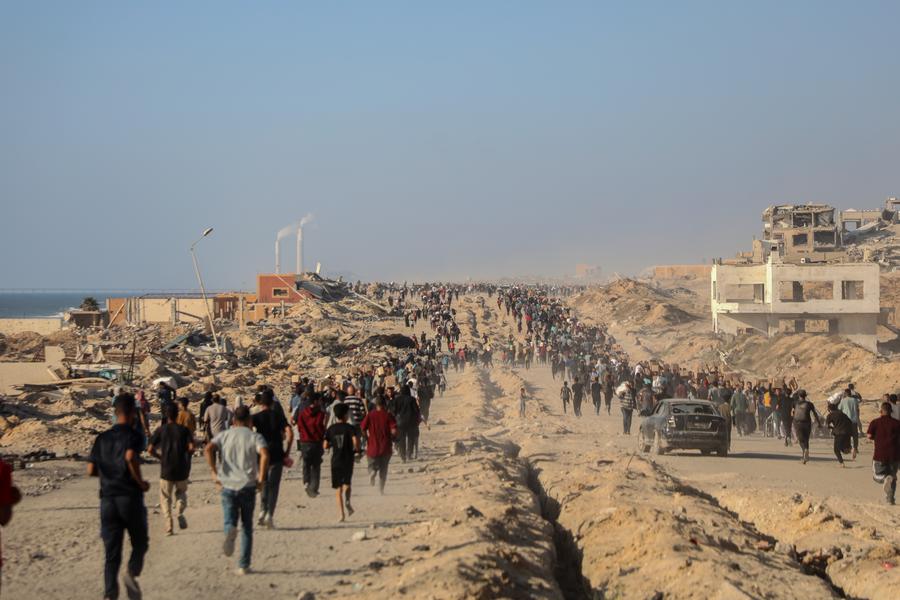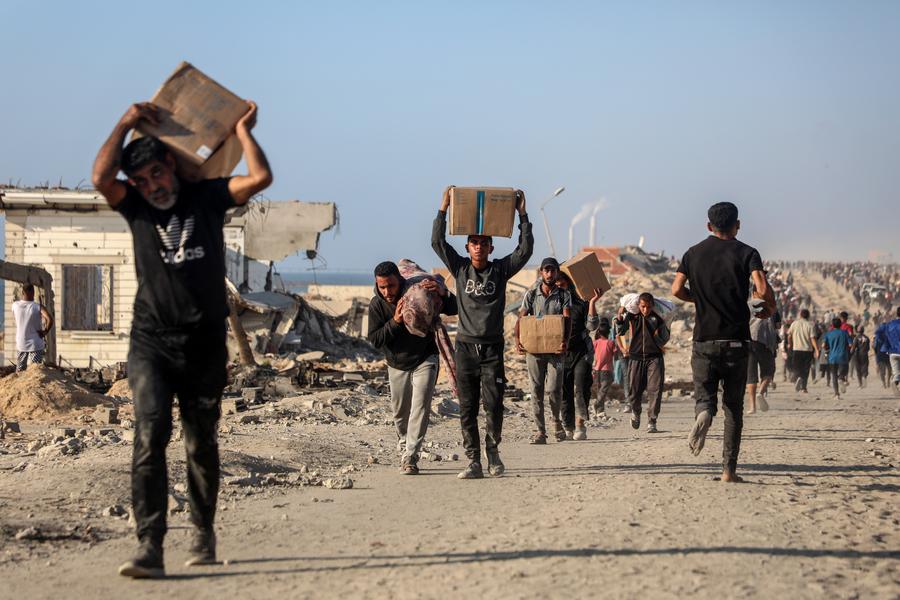


Palestinians are pictured in Gaza City, on June 16, 2025. (Photo by Rizek Abdeljawad/Xinhua)
OCHA warned that dwindling fuel reached dangerously low levels in Gaza Strip, jeopardizing critical lifelines for the population after more than 100 days with no fuel supplies. UN partners also reported that the lack of food supplies for emergency workers is causing many of them to faint.
UNITED NATIONS, June 18 (Xinhua) -- Attacks on Gaza have continued, reportedly killing and injuring scores of people, amid severe shortages of food, fuel, and medical supplies, UN humanitarians said on Wednesday.
The UN Office for the Coordination of Humanitarian Affairs (OCHA) said medical teams at Nasser Medical Complex in Khan Younis had to clear the maternity ward to make space for the injured and turn rooms into emergency operating spaces on Tuesday.
Many patients had to undergo life-saving amputations. This followed an incident where people waiting for aid were killed or injured, said the office, quoting its partners.
"We're calling on others who are doing humanitarian work to do it in a way that is most beneficial to those who receive it, that doesn't put people at risk when they're just trying to eat -- that doesn't put people at risk when they're just trying to get the bare minimum by which to survive," said Stephane Dujarric, chief spokesman for UN Secretary-General Antonio Guterres, at a briefing, when asked about a non-UN, Israel- and U.S.-backed militarized aid distribution plan.

Palestinians carry aid boxes in Gaza City, on June 16, 2025. (Photo by Rizek Abdeljawad/Xinhua)
The weeks-old scheme has claimed scores of lives when thousands-strong crowds rush to a handful of depots promising to distribute aid adjacent to militarized zones.
By international humanitarian standards, OCHA has said, aid is delivered directly to local communities so that the need to travel long distances or rush to aid hubs is eliminated.
Every day, scores of patients across the Gaza Strip need blood transfusions. As blood stocks are very low, partners are relying on daily collections to meet the increasing demand, said OCHA.
In addition to shortages of medical stocks, partners report that the lack of food supplies for emergency workers is causing many of them to faint, especially when they are called upon to respond to mass casualty incidents, said the office.
This week in Khan Younis, in-patient admissions at field hospitals have increased threefold, largely due to access challenges at Nasser Medical Complex, which borders a displacement area, it said.
OCHA warned that dwindling fuel reached dangerously low levels, jeopardizing critical lifelines for the population after more than 100 days with no fuel supplies entering the strip.

Displaced Palestinians fetch water near a temporary shelter in Gaza City amid the ongoing water crisis during the war, on June 16, 2025. (Photo by Mahmoud Zaki/Xinhua)
However, the office said that Israeli authorities approved on Wednesday a request to collect fuel from the Al Tahreer fuel station in Rafah. The last successful mission to retrieve fuel from inside Gaza was one month ago, as repeated attempts to coordinate access were denied.
"It is critical that the Israeli authorities meaningfully facilitate humanitarians' attempts to retrieve the fuel needed to power aid operations and life-sustaining services," OCHA said.
The office said its operations are on the brink of collapse, adding that it is urgent more fuel is made available to run the backup generators needed to sustain a minimal level of life-saving aid operations. For example, the Palestine Red Crescent Society reported it could only operate fewer than two dozen out of its fleet of 58 ambulances throughout the strip.
As hostilities continue, more people in Gaza have once again been forced to flee.
OCHA said that on Tuesday, Israeli authorities issued another displacement order in Khan Younis and Deir al-Balah, affecting hundreds of families living in five neighborhoods. Five primary health care centers and three medical points are located within 1,000 meters of the displacement area.

Palestinians mourn a victim killed by the Israeli army at Al-Shifa Hospital in Gaza City on June 15, 2025. (Photo by Mahmoud Zaki/Xinhua)
"While some of these areas were already under displacement orders, 3 square kilometers were newly designated, meaning the area that is currently under displacement orders or located in Israeli-militarized zones amounts to more than 82 percent of the Gaza Strip," the office said.
The humanitarians said partners visited newly established displacement sites west of Gaza City to assess the urgent needs and priorities of the displaced population.
"During the past three months, humanitarian partners estimate that more than 680,000 people have been displaced once again across the strip," OCHA said. "This includes almost 250,000 people forced to flee just in the last 30 days alone."
The office said that in Deir al-Balah and Khan Younis earlier in the week, hundreds of people, including children, benefited from teaching sessions on explosive ordnance risks, child protection and violence prevention. In Deir al-Balah, 300 children participated in recreational activities, while 100 caregivers received support and assistance.
"These activities are critical for children, particularly given the disruption of education, emotional distress, and lack of child-friendly spaces," OCHA said.
点击右上角![]() 微信好友
微信好友
 朋友圈
朋友圈

请使用浏览器分享功能进行分享
